
After almost two decades of the industry focusing on shooting more ammunition more faster, it’s great to witness the rebirth of precision shooting of all types. With that renewed interest has come wide industry product support.
Gone are the days when a new shooter had to sell a kidney and maybe a child to get a competitive bolt gun. Savage Arms, a longtime manufacturer of great bolt action rifles that hit well outside their price range, proves that you can get a heck of a lot of gun for not a heck of a lot of money with the Model 12 Long Range Precision rifle.
The Savage Model 12 LRP is the company’s entry level rifle in their Target Line. Focused on shooting off bags or from the bench, it’s on the lighter end of the rifles in the group, and is one of the few in that line that would also serve as a reasonable rifle for PRS and other modern precision shooting sports.

The particular rifle I used for this review is owned by another TTAG writer. When I picked it up for review, it didn’t include a barrel log book (SHAME!), but it had somewhere between a couple hundred and less than a thousand rounds through it.
I only put 300 more through it for this review over the month I had it. That’s about 10% of the barrel life and plenty to figure out if there was something wrong with the reliability of the gun.
There isn’t.
Model 10, 110, or 12, it’s still a Savage bolt action rifle. I’ve said it before, and I’ll keep saying it, if there was one bolt action rifle I owned to walk out of the house with and know it would perform anywhere in the world, it’s my Savage 110 in .30-06.
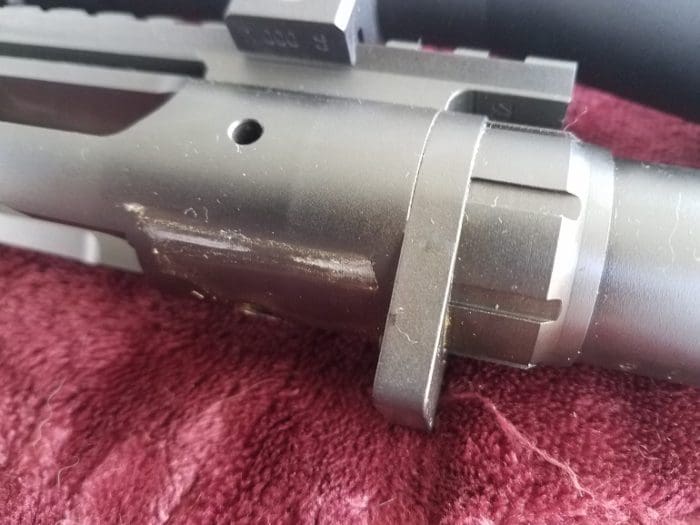
This is Savage’s Target Action, which as far as I can tell, means it’s Savage’s action with the Target AccuTrigger. It is not the single shot solid bottom metal version that I thought was the Savage Target Action. This one, obviously, has bottom metal cut out for the magazine.

It has the same smart floating bolt head design it has always had, allowing the shooter to swap out bolt heads within a family of cartridges. It also uses the same barrel nut system, allowing the shooter to easily and inexpensively swap out barrels with just a couple of gauges and a barrel nut wrench.
This is particularly valuable if you intend to shoot the three calibers (.243 Win, 6.5 CM, and .260 Rem) that this rifle is available in. Shoot a lot — and I hope you do — and you’ll be needing a new barrel eventually. (Hopefully sooner rather than later!)
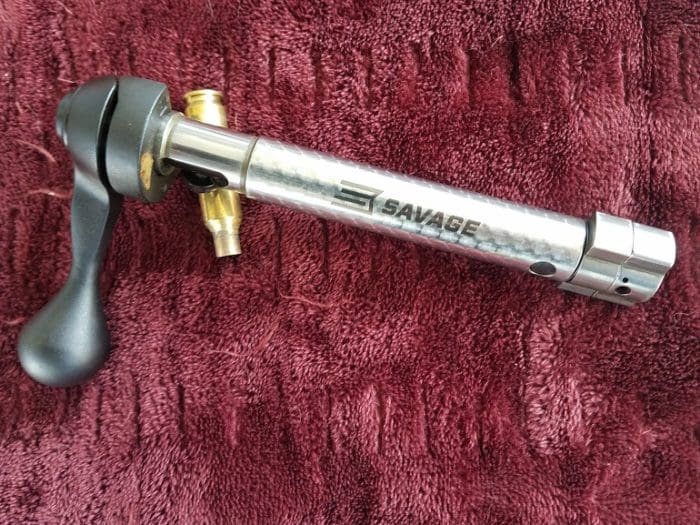
With that action, you’ll find a machine jeweled bolt, with its traditional squared flush bolt lugs. I’m not a huge fan of machine jeweled bolts.
A jeweled bolt, done right, catches the eye and shines like, well…a jewel. It is indicative of the fine care taken on a truly custom firearm. Machine jeweled bolts, like this one, tend not to catch the light much, and generally look worn right out of the box.
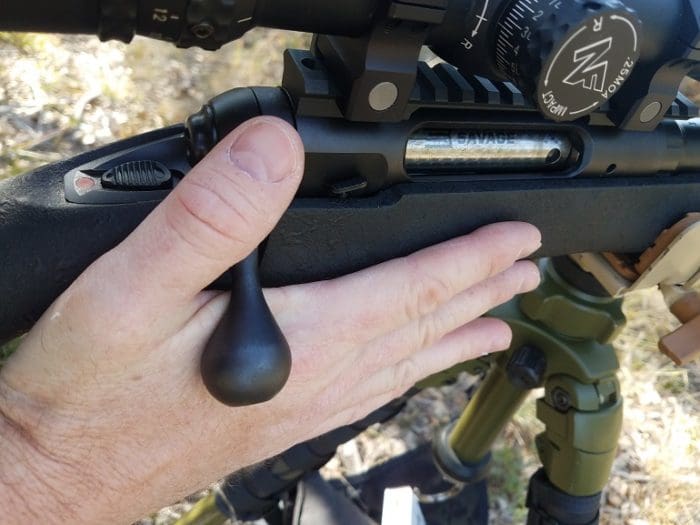
That bolt includes a very enlarged bolt knob. If this were a hunting or a brush gun, that knob sticking out would be an issue. But it isn’t, and it’s not.
Instead, it means that the shooter can quickly throw the firing hand up to get under the bolt with the web of the hand and rapidly work the action for a sure ejection and reload.

The Model 12 Long Range Precision rifle features a heavy 26″ barrel. Six deep flutes run most of the length of the barrel. The button rifled tube features a 1:8 twist, which should have no issues stabilizing bullets in the 120-149 grain weights common in the 6.5 Creedmoor.
With the length and profile of the heavy barrel, the balance of the rifle is a few inches in front of the receiver, even with the heavy stock and a heavy scope mounted. My only disappointment is that it is not threaded.
Yes, a suppressor on the end of a 26″ heavy barrel makes for a long, heavy gun. But since this gun was meant to sit on bags or on a bench anyway, adding the option of keeping it quiet certainly wouldn’t hurt, and could only serve to keep everyone’s hearing safe.
That said, I fully realize very few target-focused rifles share this feature.

The Model 12 Long Range Precision rifle’s fiberglass stock is custom-made for Savage by H-S Precision, a company with a well deserved reputation for long range precision stocks, and includes the integral “V-Block” aluminum bedding block.
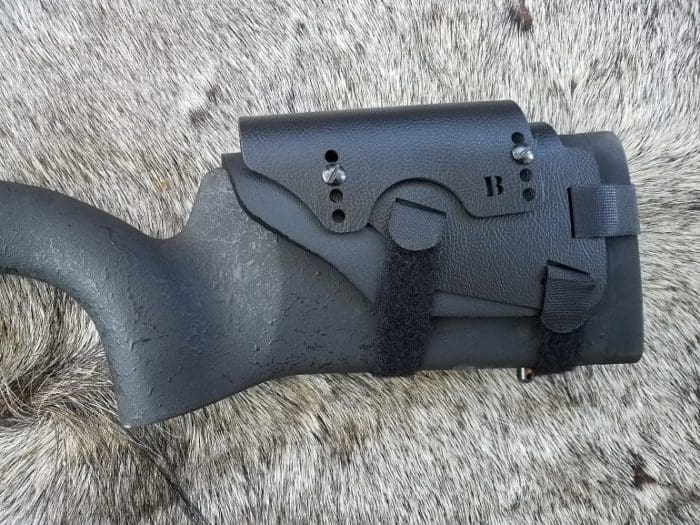
This particular stock has no adjustment for length-of-pull or comb height. Many shooters, (like the one who owns this gun already has), would do well to purchase an aftermarket cheek piece. If you so prefer, you could do like lots of shooters have been doing for decades, and tape down a kitchen sponge or two until you get the right height instead.

The lack of a length of pull adjustment is a concern, but you could always shim it up if more space was needed. It’s always a little harder to take those inches away, which is why those of smaller stature may need to reconsider this rifle, or be willing to do a little surgery to get the stock where you need it.

The HS Precision stock made for this Model 12 includes a wide palm swell with a vertical drop on the grip. It also includes a very wide, flat fore stock with a rounded flare at the bottom. This makes for ideal shooting from a front bag.

It’s also just narrow enough to fit inside the Hog Saddle Pig Saddle and tripod I’ve come to love. But just barely. Still, with the wide swell along the sides, the saddle gets a great grip on the gun, and it’s very stable from this position.
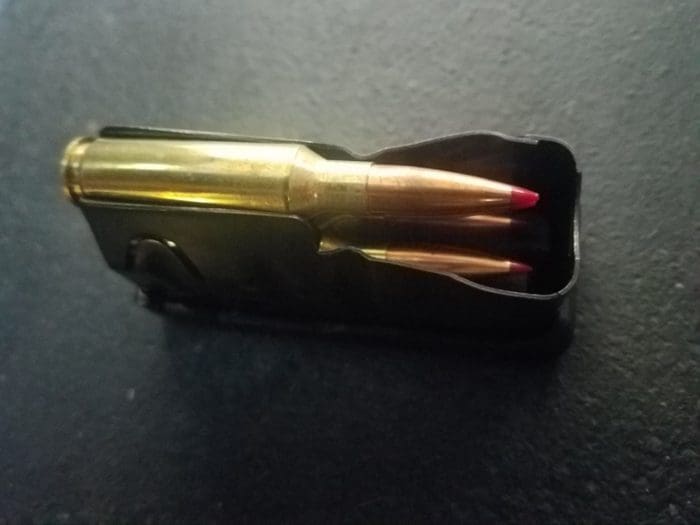
The standard Savage short action detachable box magazine holds four rounds, double stacked with the exception of the top round. I was able to load a round in the chamber, then load a full magazine, although it required a good amount of pressure to do so.
The bolt never had any issue pushing the round from the magazine. The magazine never failed to load, lock, or drop easily with the press of the magazine release, just forward of the box.
At 11 lbs empty, she’s a hefty girl. With the Nightforce NXS 8-32X56 scope mounted and a full magazine, the Model 12 LRP rifle tips the scales at 15 lbs. That’s without a bipod.
That weight shows you exactly what this rifle is made for — carrying little, shooting much. In any of the calibers it’s chambered in, the Model 12 Long Range Precision has almost no noticeable recoil.
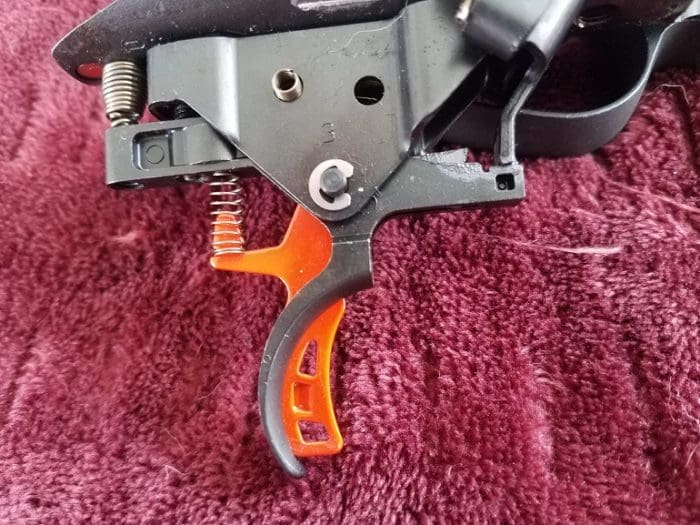
The trigger, however, is plenty light. Especially if you want it to be. I didn’t realize that the Savage’s AccuTrigger came in two different varieties. This one is their “Target AccuTrigger” and it adjusts from 2.5 lbs all the way down to a scant 6 oz.
This one was set at 14.4 oz on my Lyman trigger scale, just barely shy of a single pound.
At 6 oz, triggers go off when you carefully touch them. Savage keeps this from happening, as well as accidental detonations, with the integral blade of the AccuTrigger line. That blade, once depressed, moves the sear block out of the way prior to the actual trigger being pulled.
Without it, even if the sear dropped from being jarred, the block should keep the firearm from discharging. Should.
I had the opportunity to let several new shooters try their hands at tiny groups with this gun. Three shooters, only one of whom had ever shot a center-fire rifle before and even then not much, got behind the gun.
With just few rounds of practice, two of them were able to hit a 1″ target 3 for 3 at 100 yards off a bench. (The third guy couldn’t hit a 19″ silhouette at 50. He was just terrified of the gun. We’ll keep working on him.)
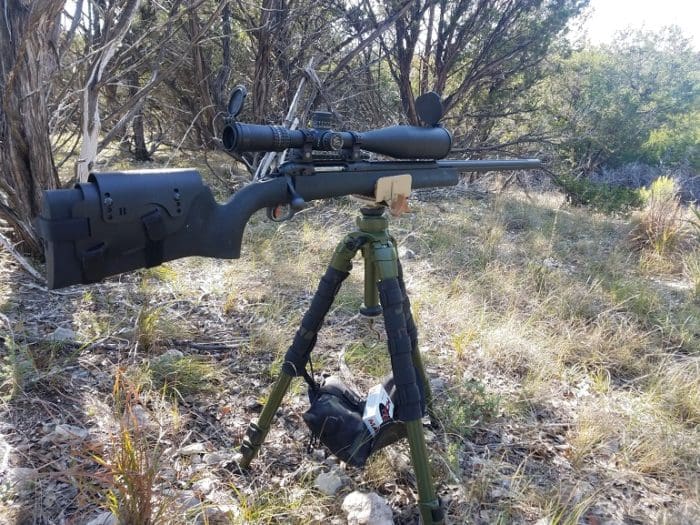
It’s really that easy a gun to shoot. Much of that is due to the stable platform of the Model 12 LRP’s stock, the feather-light trigger, and the simple mass of the rifle.
It’s not easy to carry, and it’s not easy to shoot extended strings off-hand. But that’s not what this gun is for. Rested on, well, anything, this gun is an easy, rewarding shooter.
For a stock rifle of its kind in this price range, the Model 12 Long Range Precision performs very well. Fortunately, 6.5 Creedmoor ammunition is extremely easy to find now. It’s at every one of my local gun stores, Cabela’s, and even the feed store nearest our farm.
Shooting 20-round boxes, I fired four five-round groups and averaged the results of each box. All shooting was accomplished with the supplied Nightforce NXS 8-32X56 turned to 32X magnification from a Caldwell Stinger shooting rest.

The best shooting factory round was the 140gr Hornady ELD-Match round, producing extremely consistent 1/2″ groups. The inexpensive 120gr OTM American Eagle round averaged 5/8″, with not quite the same level of consistency as the 140gr ELD-M.
Proving that barrels can be finicky beasts, the worst performing round was the Hornady 147gr ELD-M, printing consistent groups, just consistently larger than the bullet only 7 grains lighter, at 3/4″.
Those seven grains made a big difference, percentage wise. So I got another couple of boxes and headed to the Range at Austin to verify those results. A second round of shooting two new boxes at 100 yards indoors confirmed the initial shooting results.
From the worst shooting round to the best, any of those factory rounds performs well enough to be competitive in almost any of the shooting sports, save F Class. Development of a custom load at home would likely produce even better results.
Note that we’re only talking about a quarter of an inch or so difference in all of the commercial rounds tested. That’s fantastic consistency from a factory stock gun.
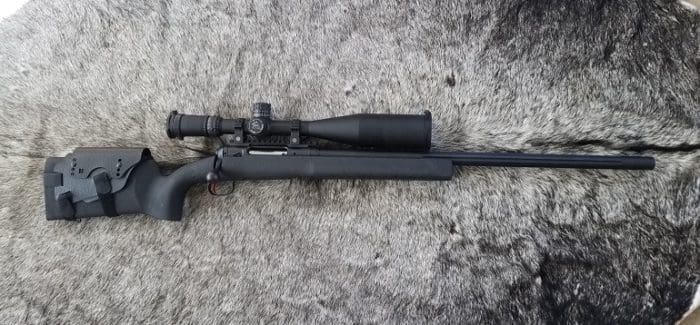
It’s nice to see more and more people interested in precision and long range shooting getting behind Savage rifles. When it comes to stock actions, I find them fundamentally better than the ubiquitous Remington.
The Model 12 Long Range Precision puts together what shooters want most. A good, rigid stock, accurate barrel, and a great trigger, all at a very reasonable price. It’s an excellent choice for the entry-level competitor, especially if they are choosing to shoot commercial 6.5 Creedmoor ammunition.
SPECIFICATIONS: Savage Model 12 Long Range Precision Rifle
Caliber: 6.5 Creedmoor
Barrel Finish: Matte
Barrel Length (in): 26
Barrel Material: Carbon steel
Magazine Capacity: 4 rounds
Hand: Right
Length of Pull (in): 13.75
Magazine: Detachable box magazine
Overall Length (in): 46.25
Rate of Twist (in):1 in 8
Receiver Color: Black
Receiver Finish: Matte
Receiver Material: Carbon steel
Type: Centerfire
Stock Color: Black
Stock Finish: Matte
Stock Material: Synthetic
Weight: 11 lbs.
MSRP: $1,310 (about $1,150 retail)
Style and Appearance * * *
Black on black. The finish is done well, but there’s nothing particularly striking about the gun in any way.
Reliability * * * * *
It’s a traditional Savage bolt action rifle action. I’d have been really surprised if anything went wrong. Nothing did.
Customization * * *
A big star off for no length of pull or comb height adjustment and a lack of a threaded muzzle. A star added for being a Savage and the ease of barrel swaps. It averages out to average.
Accuracy * * * * *
Legit 1/2″ center-to-center groups with factory ammunition is what it takes to get to 5 stars in a rifle of this class. With a custom load, I wonder how well it could really perform.
Overall * * * *
The perfect reliability, ease of barrel swaps for calibers that will definitely need them, and 1/2 MOA factory ammo groups put this rifle over the average for other rifles in its category. If I wanted another bench or varmint rifle, this would be high on my list.

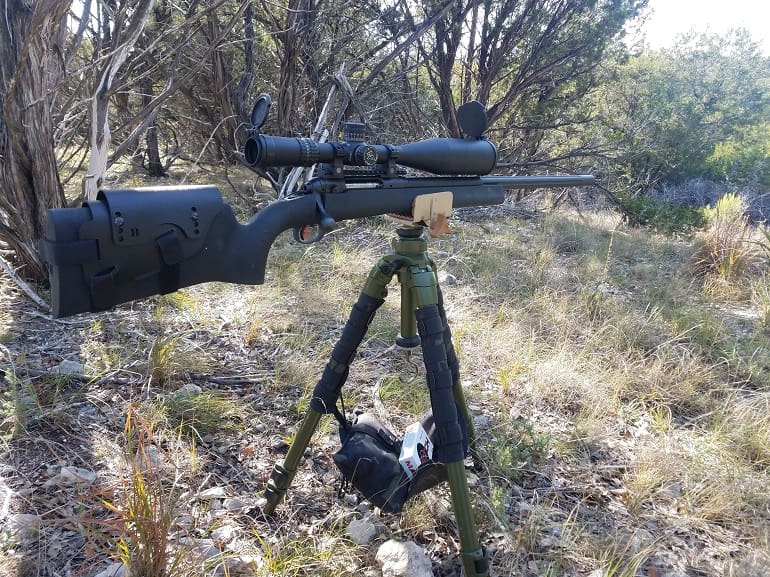


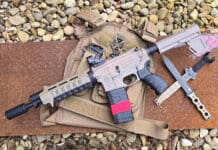
Was that a Hog Saddle and tripod setup from US tactical???
Just curious. Got one on order but they are out of stock on the Saddles at the moment. Looking forward to it so hope it works wel
I got it from Kiote Rifles. You can also get them directly from Shadow Tech.
Thank you
‘When it comes to stock actions, I find them fundamentally better than the ubiquitous Remington.’ – I’m not a huge fan of Remington, but I was considering a 700 5-R. Of course the first thing I’d have to do is install a Timney trigger (probably before I mount a scope). These long range bench rifles are just too heavy. I need something I can pack into the hills if the SHTF. Also, the 5-R comes in .308. At least this one comes in .260. Too bad they stuck you with the Crapmoor.
I’ve been very happy with my Remington 5-R in .308Win. It might be the only Remington gun I’ve been particularly impressed with for a while. I actually bought it for my son, but then I took a couple dozen deer with it and competed with it some last year. Mine really likes the 175gr Nosler RDF bullet.
I’m a big fan of the 6.5CM. Turns out SOCOM made the right call.
“It might be the only Remington gun I’ve been particularly impressed with for a while.”
Are you not the one who penned the glowing review of the Versa Max Tactical? Calling it your go-to gun over all others? Pretty sure that shotgun is made by Remington..
‘I’m a big fan of the 6.5CM.’ – Yeah, yeah, yeah… I know they’re the exact same cartridge but I’ve got a .260 and sometimes you just have to take a stand, even if it is kind of pointless.
Thanks for the insight on the 5-R. Haven’t actually decided between the gen. 1 or 2, leaning toward the shiny one though.
Thank you. My first “real” rifle was a custom Mauser in 6.5-08 that my grandfather had built for a safari. In the 60’s sometime. Luckily for me his hunting partner (and BIL) slapped some sense into him and he took his x55 instead. He gave it to me for my 12th b-day in ’77. I’ve been a 6.5 guy ever since and I own a whole bunch that never caught on. Lazzeroni? Oh yeah. Wildcats? If you can neck it to 6.5 I messed with it. And Creedmoor is the one that takes off? Yeesh.
‘And Creedmoor is the one that takes off? Yeesh.’ – Probably because they named it after a mental hospital in NYC.
Although I haven’t officially ruled out Satan…
Reviews should START with accuracy results First. There’s no need to read all the other good or bad points if the firearm won’t deliver with its primary task. This Savage delivers and the article is a informative good read. Following Accuracy data should be the Price. Its not that price can be a show stopper, it sets a bar under which all the pros/cons can be considered: minor issues on a big ticket $ gun are worse than the same issues on a much cheaper gun. Like wise features that have/add intrinsic value above expections of that price bar stand out.
Yeah, I understand all authors want their script widely read and host sites want to put Links into the field of view to make a few bucks. However, a “Click” to open the article counts in the tally whether fully read or not. Try this up front format and see what feedback you get.
Thanks, but no thanks.
I welcome you to write your own reviews, get them published here, and see how well they do. TTAG is always looking for writers. https://www.thetruthaboutguns.com/write-for-us/
They must grow em with really thin skins in his part of Texas. Maybe you should first seek to understand why these rifles are built they way they are and for what shooting discipline before you go deducting stars for features that are designed specifically for particular shooting sports.
You’re welcome to write a review in the style you think reviews should be written and submit it for publication here. Send it to [email protected].
Although it’s getting too cold around here now to do a serious accuracy test for review, I wish the tester/reviewer would move the bar for accuracy out to say, 400-500 yards rather than just the standard 100 when playing with precision rifles. I’ve got at least 2 M70 FWTs (.243 and ’06) that will shoot under an inch at 100 yards. Trying to be a constructive critic rather than dissing the reviewer, but the implied usage of such rifles is to shoot more distant targets, isn’t it?
I enjoy dropping in some 600 yd pills from my old SSG 69 several times a year. That’s fun, and instructive as to what one can hit at longer distance. I really got my eyes opened at the Labor Day Whittington Center donor days last Sept. I had the opportunity to shoot a Hill Country Rifles .338 Lapua at a measured 1 mile distance. The guys spotting and doping were the real heroes, but with their coaching was able to put the final 3 rounds of 5 into a triangle that could be covered by a 12″-14″ square. They knew the rifle, did the sighting and could read the wind. Anyway, that’s what I’m looking for.
The problem with long range accuracy testing is that it invites too many other variables to use as a benchmark.
If I had a 500 yard indoor range to control wind and other atmospherics, it would make sense. I don’t.
I also a big fan of savages. I’ve only got one I haven’t shot yet. Going to try and get that up and running next spring. It’s a beautiful old school wood stock in 7 mag inherited from dad.
Can’t wait to see what it’ll do.
Tom in Oregon,
I think I mentioned here before. Even if I did, it bears repeating. Last year on Black Friday I purchased a Savage Axis XP chambered in .243 Winchester for something like $220 after factory rebate. I was astounded at how accurate it was. Using nothing more than sandbags on a concrete bench at a NICE public shooting range, I was shooting amazingly tight groups (3/8 inch groups?) at 50 yards with inexpensive Winchester Super X softpoint hunting cartridges. And I wasn’t exactly taking all afternoon to pull the trigger for perfect shots, although I was trying to be accurate within reason. (Disclaimer: I consider myself an above average shooter although definitely not exceptional.)
I can imagine that someone with excellent shooting ability, match grade ammunition, and a high-quality shooting rest/jig, would probably shoot even better groups. I’ll bet that inexpensive rifle is easily capable of 3/4 inch groups at 100 yards.
And to emphasize my newfound delight, I purchased the same rifle in 6.5 Creedmoor two weeks ago on sale for $225 after factory rebate. How can you possibly go wrong with a rifle that shoots that well with its surprisingly good Weaver scope from the factory? (Will this new rifle shoot as well? I will find out whenever I get around to a shooting range.)
Sense,
I have bought 2 Savage axis II XPs in the last 2 weeks. Both chambered in 7mm-08. I bought 1 type of ammo Hornady Whitetail. The first puts out Sub MOA groups at 50 yards(clover leafs) the second rifle is the axis II 2.0 version with the lighter stock, with the same ammunition I am getting (2″ groups at 50 yards) 4 moa groups. I will try other ammunition with that rifle. While that type of accuracy will indeed kill deer, I was dissatisfied in that second rifle not liking my preference of ammunition, I will try other loads and taking it to a 100 yard range soon.
Why 50yards, I have an indoor 50 yard range not far from where I live. 50yard zero is a 200 yard zero for that caliber/bullet weight.
Jeff the Griz,
There are two additional important reasons that I sight-in at 50 yards.
The most important reason: that reduces variability because of cross winds. From one shot to the next, cross winds could easily range anywhere from 2 m.p.h. to 12 m.p.h. At 100 yards the difference in wind drift due to differences in cross wind speed is about 0.80 inches. That is a HUGE difference if you are trying to determine which bullets group the best AND IF YOU ARE TRYING TO ALIGN YOUR SCOPE with point of impact. At 50 yards, the difference in wind drift (from 2 m.p.h. cross winds to 12 m.p.h. cross winds) is 0.3 inches, a much smaller change.
Another reason that I sight in at 50 yards: the intersection of the lines on the reticle look smaller relative to the target. That means I can position the cross of the reticle more precisely in the actual middle of the target. Whereas at 100 yards, the cross of the reticle covers a more substantial area and I could easily be off by 0.25 inches from one shot to the next just due to the relative size of reticle compared to the center of the target. Of course that error would be half that at half the distance, thus a 0.125 inch error at 50 yards is pretty small.
Now, add that previous 0.25 inch error from reticle size to the previous 0.8 inch error due to variable velocity cross-wind drift and your shots could easily stray as much as 1.05 inches from shot to shot at 100 yards versus 0.4 inches from shot-to-shot at 50 yards. In other words you could have a perfect barrel and perfect ammunition and still see a one-inch shot group. (And cross-winds could push the center of that group about 5/8 inch to the left or right of the point of aim.)
Those are the two most compelling reasons that I sight my rifles at 50 yards. When I am finished sighting in, I might take a few shots at 100 yards just to verify that group sizes have not completely gone out the window and to verify that my group is hitting above the point of aim by the amount that ballistic calculators predict. (I zero rifles for 200 yards which means that bullet trajectory will be high at 100 yards, typically on the order of 1.5 inches high.) Unless that shot group at 100 yards is way off from what I expect, I call it a day.
Jeff the Griz,
I re-read your comment and now I am wondering if you have a scope or scope-mount defect on that rifle that is shooting 2-inch groups at 50 yards.
A couple years ago I purchased an inexpensive break-action rifle chambered in .44 Magnum. I really struggled to get any ammunition to shoot acceptable groups at 50 yards. (Best I ever achieved was about 2.5 inch groups with one particular brand of ammunition.) This last weekend I removed the scope so that I could correct a firing pin (light primer strike) problem. When I replaced the scope, I noticed that it wobbled slightly. Turns out the scope mounting rail was loose. I tried tightening the mounting screws on the mounting rail but they would never get very tight. Are you ready for this? The manufacturer shipped that rifle with mounting screws that were too short for the scope mounting rail! The screws extend at most 1/16th of an inch past the mounting rail and were just barely biting into the tapped holes on the rifle’s barrel.
I ordered longer screws from Brownells which are supposed to arrive on Friday. (Turns out even the best local hardware stores do not carry #6-48 screws, go figure!) I am really hoping that will enable me to shoot much tighter groups at 50 yards.
Anyhow, I wonder if your scope mount is loose or if the scope itself is defective. (Its reticle could be loose.) You can obviously check that your scope mount is solid — just try to wiggle it with your hands. I believe you have to try a different scope to determine if your factory scope is defective.
If it turns out that your barrel is a lemon, I’ll bet that Savage will replace it for you under warranty.
“Can’t wait to see what it’ll do.”
Tom, I imagine it will do anything you’d ever need. Great combo.
I’ve got one of these and I love it.
If you tune down the trigger a bit too much it will lock up unless you pull it perfectly straight back, but at a reasonable trigger weight it’s great.
Mine will put 10 rounds in .3 MOA with handloads if I take my time. I’ve got consistent hits on a 3” gong at 900 yards and I’ve lucked out with it at a mile on a windy day.
Definitely not bad for a $900 rifle.
I’m rebarreling it this year and I’ll put it in a chassis soon, but I won’t ever get rid of it.
Nice review..completely off topic (sorry) but am curious about that beautiful Ruger No.1 you had customized, any updates?
For some reason I can’t reply to uncommon sense, but our local ace hardware carries gun screws. You might check there.
Hi all. I bought one of these rifles in 6.5 CM at the start of 2018 and immediately got into customising it to my needs. The first thing was I got rid of the stock and fitted a MDT ESS chassis – with a A.I. metal 11 round magazine, a cracking Delta Stryker scope (these are great by the way!) and a pair of UTG bipod legs which attach to the M-Lok on the chassis. It was now rock solid!! Developing some home loads using Nosler RDF 140 grain bullets in once used Hornady brass, Federal match primers and RS62 powder (44.5 grns) giving 2800 fps. Once I’d sorted out seating depths I was getting 1/3 inch groups at 100 yards.
The real proof of its accuracy was when using it at a very large mountainous range in Wales, U.K. back in September, where it was raining, chilly and a full value – tricky wind at around 25 mph. Hitting the center of a steel plate at 800 yards made me smile, then I was asked to take 3 quick follow up shots to try for a group. Getting them off as quick as I could, I placed 3 shots a tad lower than the first center shot and managed a 3 round group of 68 mm / or fractionally under 2.75 inches.
I love this rifle now and I would certainly recommend them to anyone!
Inspired from the tv series Yellowstone, this Kelly Reilly Blue Coat is poncho-style outerwear. Kelly Reilly portrayed the role of Beth Dutton, daughter of John Dutton in the series.
If you love to wear action movies and games outfits so must check the top 5 superb Cosplay Jackets which gives you a killer and stunning look on this cosplay festival.
“HUAYDED789 หวยออนไลน์ 24 ชั่วโมง ระบบที่ทันสมัย แทงหวยง่าย โอนเงินไว หวยออนไลน์ที่นี่จ่ายสูง ส่วนลดเยอะ โปรโมชั่นพิเศษสำหรับสมาชิกใหม่ และสิทธิพิเศษมาก มาย แจกเครดิตฟรีอย่างต่อเนื่อง”
I have the 6.5 Creedmoor version as well, and I have 3 complaints with mine. the extractor is not reliable and all on my, or my 110 fcp in 338 lapua. the other is the trigger on both seen l seem to not move the seer out of the way enough, more so in the regular accutrigger on the 110 than the target accutrigger. The third being that I have about 500 rounds through it, and the barrel no longer stabilizes bullets. I was getting 1/4″ or less groups with 147ELD-M hand loads consistently. Time for a new barrel!
not reliable on mine, or my 110FCP in 338 lapua.
Sorry for the typo
Comments are closed.